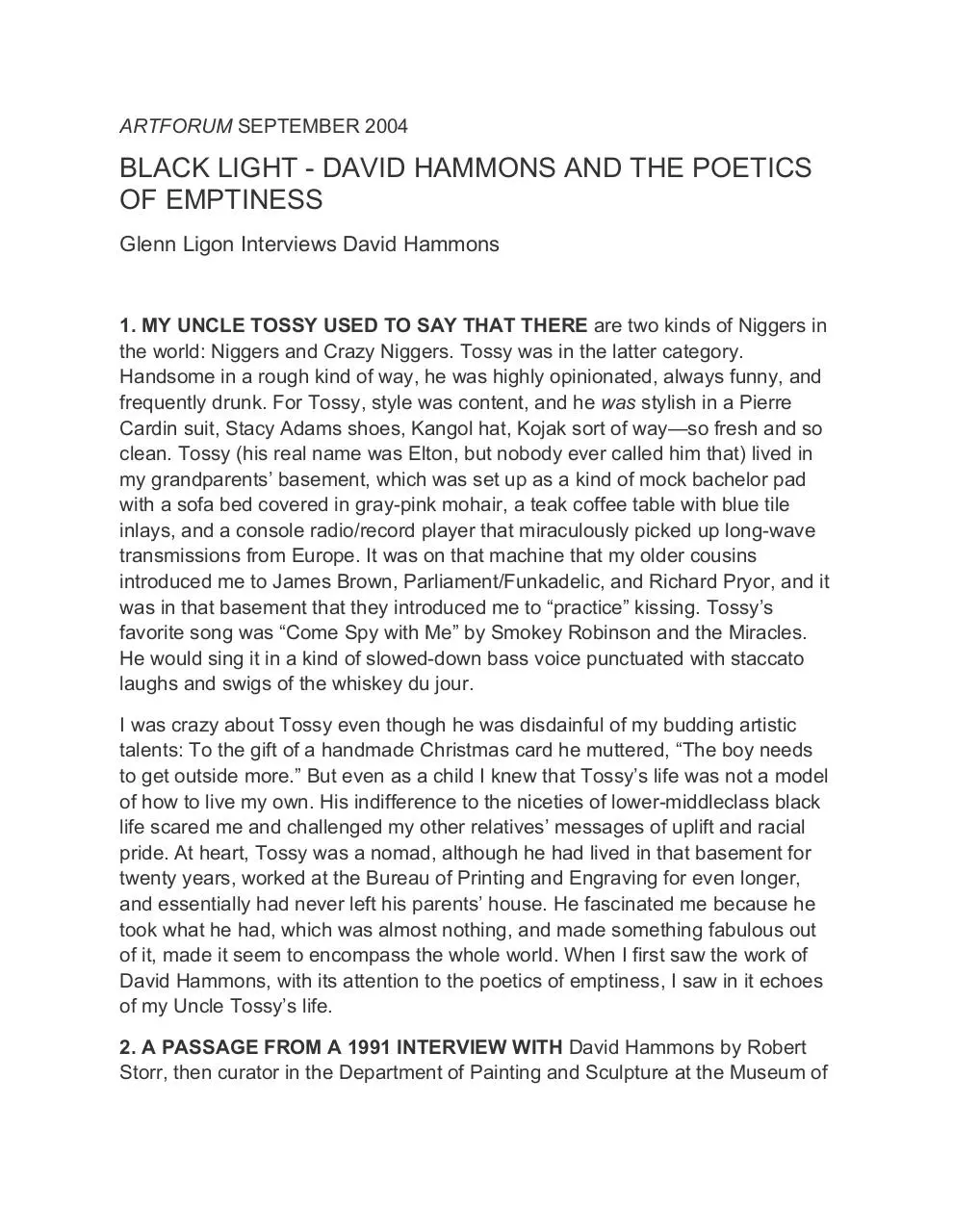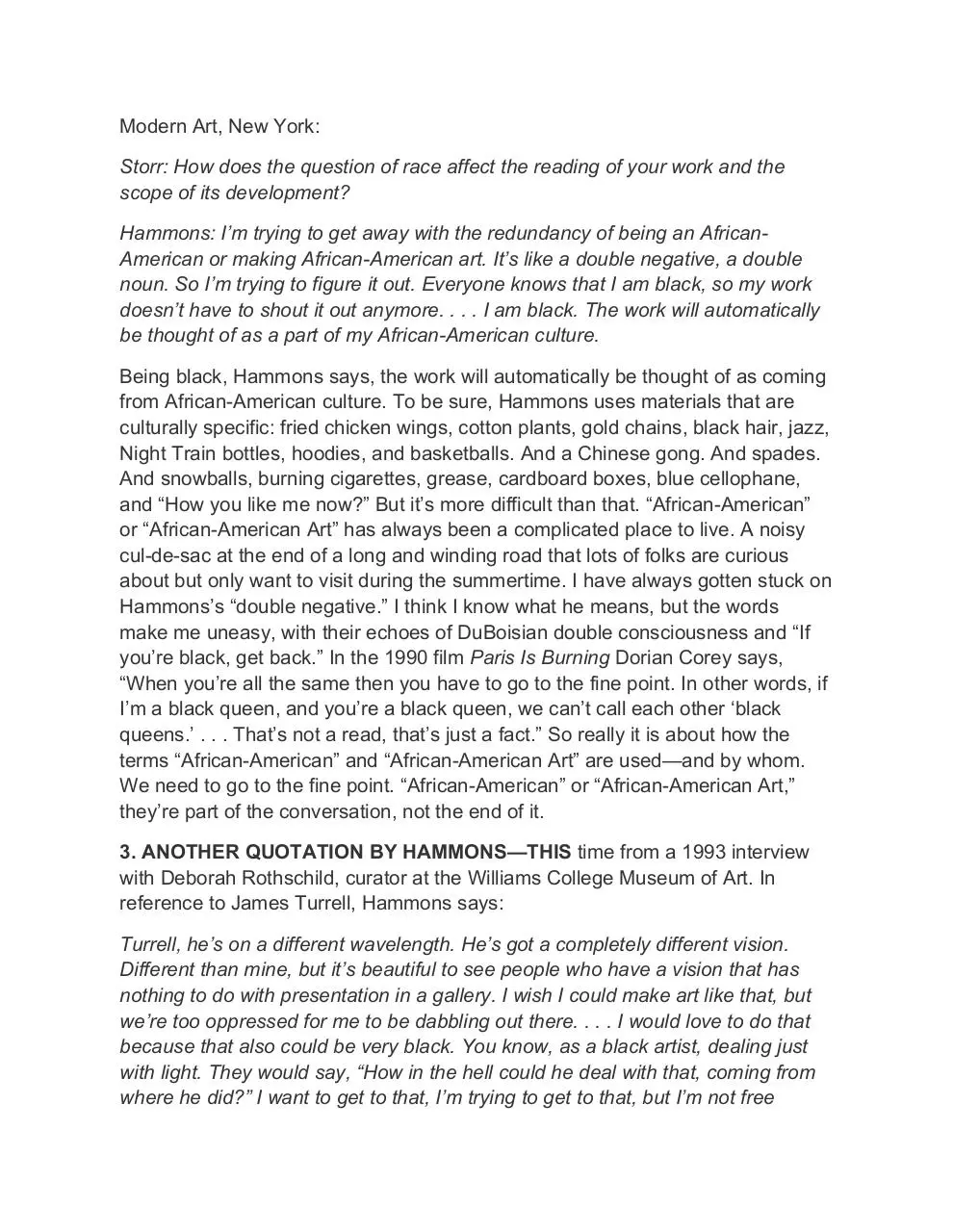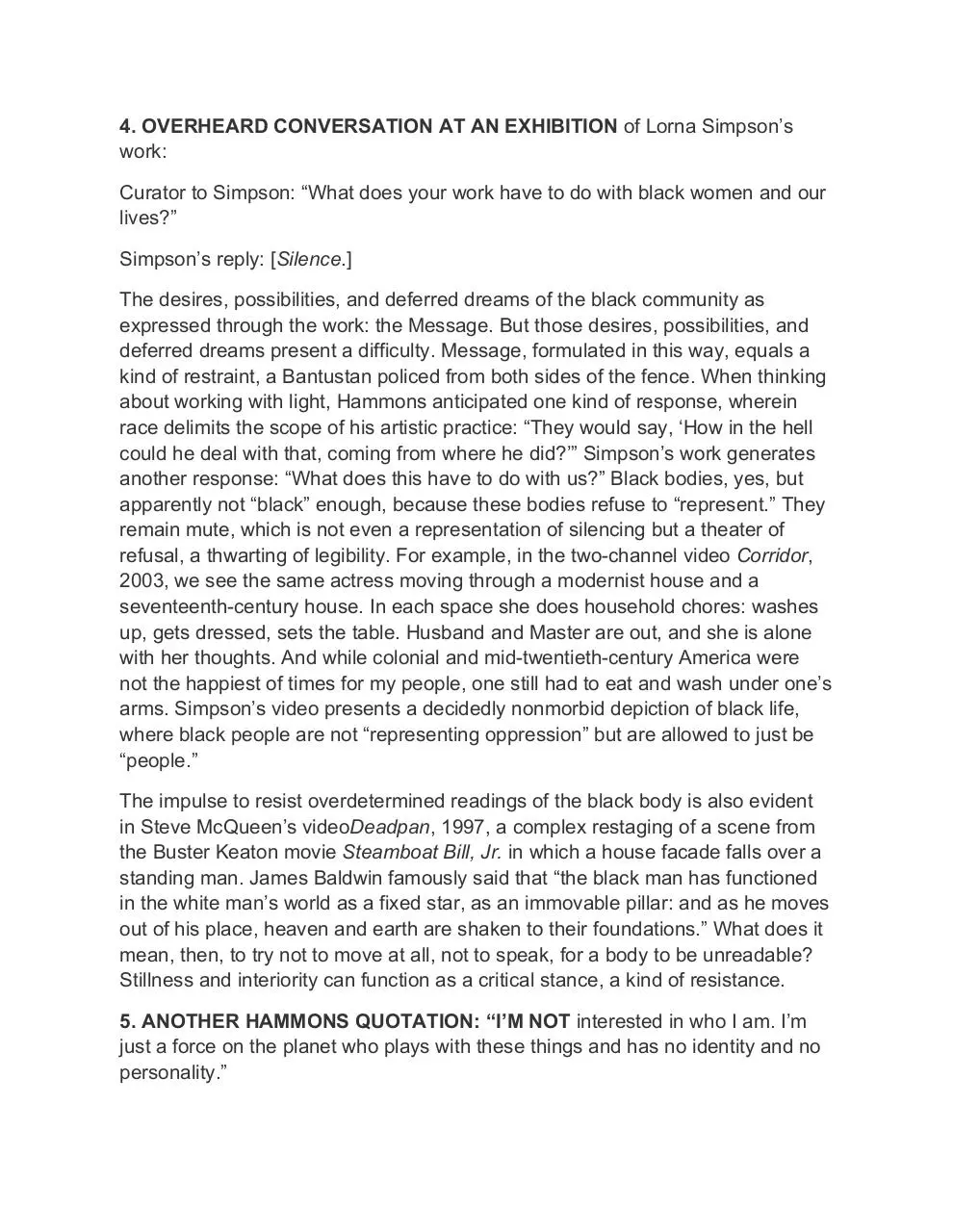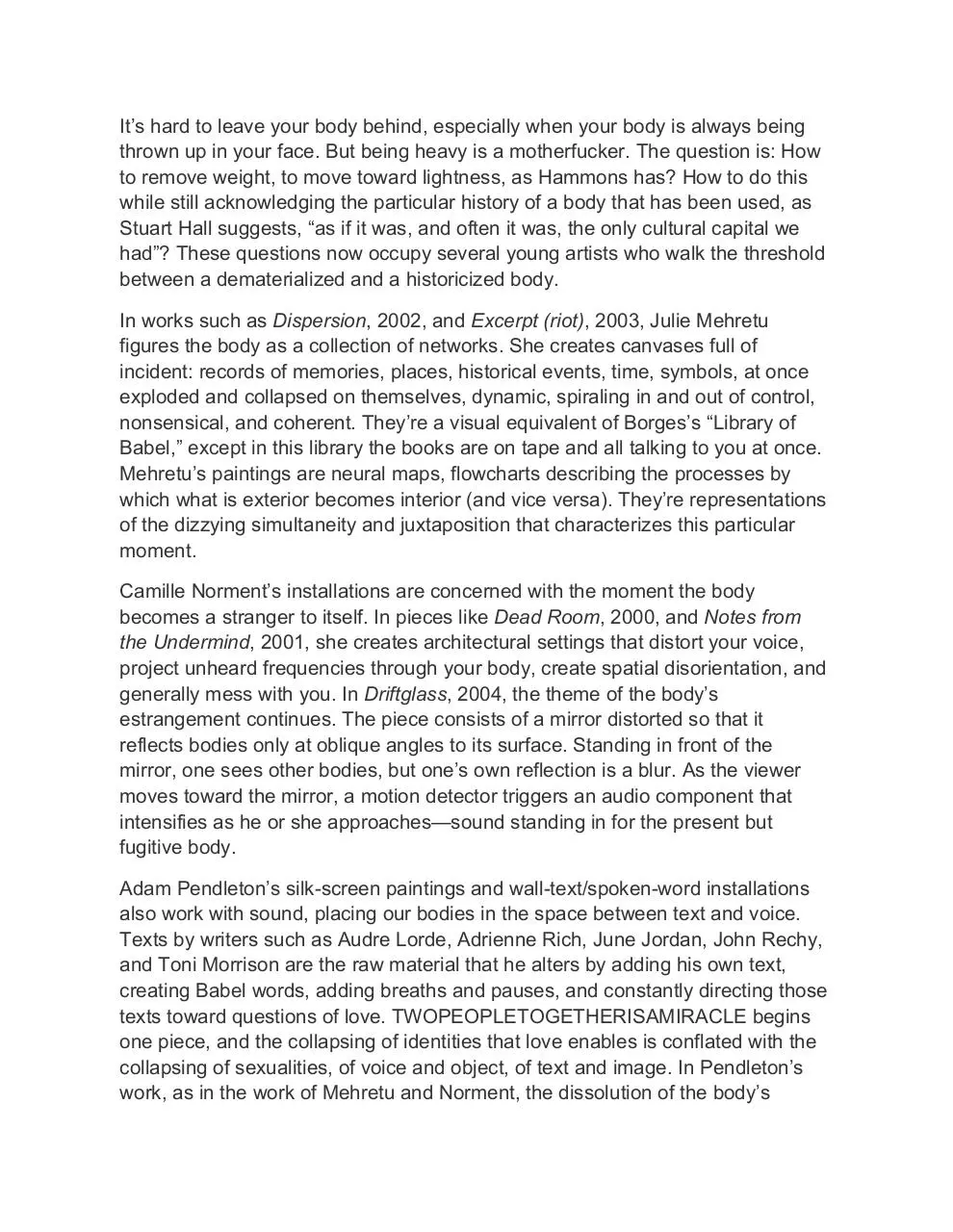BLACK LIGHT DAVID HAMMONS & THE POETICS OF EMPTINESS (txt) (PDF)
File information
Title: BLACK LIGHT - DAVID HAMMONS AND THE POETICS OF EMPTINESS
This PDF 1.3 document has been generated by TextEdit / Mac OS X 10.11.5 Quartz PDFContext, and has been sent on pdf-archive.com on 04/07/2016 at 19:47, from IP address 173.2.x.x.
The current document download page has been viewed 1211 times.
File size: 119.21 KB (7 pages).
Privacy: public file





File preview
ARTFORUM SEPTEMBER 2004
BLACK LIGHT - DAVID HAMMONS AND THE POETICS
OF EMPTINESS
Glenn Ligon Interviews David Hammons
1. MY UNCLE TOSSY USED TO SAY THAT THERE are two kinds of Niggers in
the world: Niggers and Crazy Niggers. Tossy was in the latter category.
Handsome in a rough kind of way, he was highly opinionated, always funny, and
frequently drunk. For Tossy, style was content, and he was stylish in a Pierre
Cardin suit, Stacy Adams shoes, Kangol hat, Kojak sort of way—so fresh and so
clean. Tossy (his real name was Elton, but nobody ever called him that) lived in
my grandparents’ basement, which was set up as a kind of mock bachelor pad
with a sofa bed covered in gray-pink mohair, a teak coffee table with blue tile
inlays, and a console radio/record player that miraculously picked up long-wave
transmissions from Europe. It was on that machine that my older cousins
introduced me to James Brown, Parliament/Funkadelic, and Richard Pryor, and it
was in that basement that they introduced me to “practice” kissing. Tossy’s
favorite song was “Come Spy with Me” by Smokey Robinson and the Miracles.
He would sing it in a kind of slowed-down bass voice punctuated with staccato
laughs and swigs of the whiskey du jour.
I was crazy about Tossy even though he was disdainful of my budding artistic
talents: To the gift of a handmade Christmas card he muttered, “The boy needs
to get outside more.” But even as a child I knew that Tossy’s life was not a model
of how to live my own. His indifference to the niceties of lower-middleclass black
life scared me and challenged my other relatives’ messages of uplift and racial
pride. At heart, Tossy was a nomad, although he had lived in that basement for
twenty years, worked at the Bureau of Printing and Engraving for even longer,
and essentially had never left his parents’ house. He fascinated me because he
took what he had, which was almost nothing, and made something fabulous out
of it, made it seem to encompass the whole world. When I first saw the work of
David Hammons, with its attention to the poetics of emptiness, I saw in it echoes
of my Uncle Tossy’s life.
2. A PASSAGE FROM A 1991 INTERVIEW WITH David Hammons by Robert
Storr, then curator in the Department of Painting and Sculpture at the Museum of
Modern Art, New York:
Storr: How does the question of race affect the reading of your work and the
scope of its development?
Hammons: I’m trying to get away with the redundancy of being an AfricanAmerican or making African-American art. It’s like a double negative, a double
noun. So I’m trying to figure it out. Everyone knows that I am black, so my work
doesn’t have to shout it out anymore. . . . I am black. The work will automatically
be thought of as a part of my African-American culture.
Being black, Hammons says, the work will automatically be thought of as coming
from African-American culture. To be sure, Hammons uses materials that are
culturally specific: fried chicken wings, cotton plants, gold chains, black hair, jazz,
Night Train bottles, hoodies, and basketballs. And a Chinese gong. And spades.
And snowballs, burning cigarettes, grease, cardboard boxes, blue cellophane,
and “How you like me now?” But it’s more difficult than that. “African-American”
or “African-American Art” has always been a complicated place to live. A noisy
cul-de-sac at the end of a long and winding road that lots of folks are curious
about but only want to visit during the summertime. I have always gotten stuck on
Hammons’s “double negative.” I think I know what he means, but the words
make me uneasy, with their echoes of DuBoisian double consciousness and “If
you’re black, get back.” In the 1990 film Paris Is Burning Dorian Corey says,
“When you’re all the same then you have to go to the fine point. In other words, if
I’m a black queen, and you’re a black queen, we can’t call each other ‘black
queens.’ . . . That’s not a read, that’s just a fact.” So really it is about how the
terms “African-American” and “African-American Art” are used—and by whom.
We need to go to the fine point. “African-American” or “African-American Art,”
they’re part of the conversation, not the end of it.
3. ANOTHER QUOTATION BY HAMMONS—THIS time from a 1993 interview
with Deborah Rothschild, curator at the Williams College Museum of Art. In
reference to James Turrell, Hammons says:
Turrell, he’s on a different wavelength. He’s got a completely different vision.
Different than mine, but it’s beautiful to see people who have a vision that has
nothing to do with presentation in a gallery. I wish I could make art like that, but
we’re too oppressed for me to be dabbling out there. . . . I would love to do that
because that also could be very black. You know, as a black artist, dealing just
with light. They would say, “How in the hell could he deal with that, coming from
where he did?” I want to get to that, I’m trying to get to that, but I’m not free
enough yet. I still feel I have to get my message out.
Ten years after that interview Hammons indeed figured out how to make light
“very black” for Concerto in Black and Blue, 2002, his exhibition at Ace Gallery in
New York. At the entrance to the gallery visitors were given tiny pressureactivated LED flashlights no bigger than gumballs. When the flashlights were
clicked on they gave off a blue light, which lasted until the pressure was
released. Visitors were ushered through a door into the main gallery space,
which comprised more than twenty thousand square feet spread over several
rooms with twenty-five-foot ceilings. The gallery was completely dark. And what
was in that twenty-thousand-square-foot space? Nothing. It was completely
empty except for the blue light emitted from your flashlight and from those of
other people walking around in the space with you.
When talking about Turrell, Hammons said, “We’re too oppressed for me to be
dabbling out there,” and “I want to get to that, I’m trying to get to that, but I’m not
free enough yet.” The movement to “get free,” to cross boundaries, is what’s
interesting in Hammons’s recent work, in particular its radical dematerialization
over the last several years. But let me reject a reading of Hammons’s project that
sets up too strict an opposition between “free” and “not free,” “message” and
“post-message,” objects and dematerialization, “white” work (Turrell) and “black”
work (Hammons). For one, Hammons’s work has never been “on point” because
it’s always too Fellini, too carnivalesque, too damn freaky-deke to be useful as a
set of cheering fictions, an expression of an essential, unchanging blackness, or
a standard-bearer for some multiculturalist agenda. What to make, for example,
of a work like Flying Carpet, 1990, where fried chicken wings are attached with
fish hooks to a Persian carpet hanging on the wall? Or Traveling, 2002, a
drawing made by bouncing a basketball covered in Harlem dirt on a piece of
paper with a suitcase stuck behind the frame pushing the drawing off the wall:
playground virtuosity, nomadism, performance art, and Rauschenberg’s tire print,
all elegantly rolled into one? Also, it would be a misreading of Hammons’s project
to describe it as a linear movement toward dematerialization, for that doesn’t take
into consideration earlier pieces like Cold Shoulder, 1990, giant blocks of ice with
coats thrown over them, or Bliz-aard Ball Sale, 1983, where the artist sold
snowballs on the streets of New York, or more recent pieces like Global Fax
Festival, 2000, an empty exhibition hall with ceiling-mounted machines spewing
faxes, or his Flashlight Drawing, 2000, which records the movement of a
flashlight in a darkened room. Process, ephemerality, and transformation have
always been part of Hammons’s work. In a word: Lightness.
4. OVERHEARD CONVERSATION AT AN EXHIBITION of Lorna Simpson’s
work:
Curator to Simpson: “What does your work have to do with black women and our
lives?”
Simpson’s reply: [Silence.]
The desires, possibilities, and deferred dreams of the black community as
expressed through the work: the Message. But those desires, possibilities, and
deferred dreams present a difficulty. Message, formulated in this way, equals a
kind of restraint, a Bantustan policed from both sides of the fence. When thinking
about working with light, Hammons anticipated one kind of response, wherein
race delimits the scope of his artistic practice: “They would say, ‘How in the hell
could he deal with that, coming from where he did?’” Simpson’s work generates
another response: “What does this have to do with us?” Black bodies, yes, but
apparently not “black” enough, because these bodies refuse to “represent.” They
remain mute, which is not even a representation of silencing but a theater of
refusal, a thwarting of legibility. For example, in the two-channel video Corridor,
2003, we see the same actress moving through a modernist house and a
seventeenth-century house. In each space she does household chores: washes
up, gets dressed, sets the table. Husband and Master are out, and she is alone
with her thoughts. And while colonial and mid-twentieth-century America were
not the happiest of times for my people, one still had to eat and wash under one’s
arms. Simpson’s video presents a decidedly nonmorbid depiction of black life,
where black people are not “representing oppression” but are allowed to just be
“people.”
The impulse to resist overdetermined readings of the black body is also evident
in Steve McQueen’s videoDeadpan, 1997, a complex restaging of a scene from
the Buster Keaton movie Steamboat Bill, Jr. in which a house facade falls over a
standing man. James Baldwin famously said that “the black man has functioned
in the white man’s world as a fixed star, as an immovable pillar: and as he moves
out of his place, heaven and earth are shaken to their foundations.” What does it
mean, then, to try not to move at all, not to speak, for a body to be unreadable?
Stillness and interiority can function as a critical stance, a kind of resistance.
5. ANOTHER HAMMONS QUOTATION: “I’M NOT interested in who I am. I’m
just a force on the planet who plays with these things and has no identity and no
personality.”
It’s hard to leave your body behind, especially when your body is always being
thrown up in your face. But being heavy is a motherfucker. The question is: How
to remove weight, to move toward lightness, as Hammons has? How to do this
while still acknowledging the particular history of a body that has been used, as
Stuart Hall suggests, “as if it was, and often it was, the only cultural capital we
had”? These questions now occupy several young artists who walk the threshold
between a dematerialized and a historicized body.
In works such as Dispersion, 2002, and Excerpt (riot), 2003, Julie Mehretu
figures the body as a collection of networks. She creates canvases full of
incident: records of memories, places, historical events, time, symbols, at once
exploded and collapsed on themselves, dynamic, spiraling in and out of control,
nonsensical, and coherent. They’re a visual equivalent of Borges’s “Library of
Babel,” except in this library the books are on tape and all talking to you at once.
Mehretu’s paintings are neural maps, flowcharts describing the processes by
which what is exterior becomes interior (and vice versa). They’re representations
of the dizzying simultaneity and juxtaposition that characterizes this particular
moment.
Camille Norment’s installations are concerned with the moment the body
becomes a stranger to itself. In pieces like Dead Room, 2000, and Notes from
the Undermind, 2001, she creates architectural settings that distort your voice,
project unheard frequencies through your body, create spatial disorientation, and
generally mess with you. In Driftglass, 2004, the theme of the body’s
estrangement continues. The piece consists of a mirror distorted so that it
reflects bodies only at oblique angles to its surface. Standing in front of the
mirror, one sees other bodies, but one’s own reflection is a blur. As the viewer
moves toward the mirror, a motion detector triggers an audio component that
intensifies as he or she approaches—sound standing in for the present but
fugitive body.
Adam Pendleton’s silk-screen paintings and wall-text/spoken-word installations
also work with sound, placing our bodies in the space between text and voice.
Texts by writers such as Audre Lorde, Adrienne Rich, June Jordan, John Rechy,
and Toni Morrison are the raw material that he alters by adding his own text,
creating Babel words, adding breaths and pauses, and constantly directing those
texts toward questions of love. TWOPEOPLETOGETHERISAMIRACLE begins
one piece, and the collapsing of identities that love enables is conflated with the
collapsing of sexualities, of voice and object, of text and image. In Pendleton’s
work, as in the work of Mehretu and Norment, the dissolution of the body’s
boundaries is seen as a productive moment, where the fusion of the body to
history, to space, to sound, and to language points toward new possibilities.
6. THE ARTIST MARC ROBINSON STANDS IN A gallery in front of a portrait of
Malcolm X with red lipstick and blue eye shadow. A woman sees the painting
through the window and comes inside. “Are you the artist?” she says. He is not,
but he nods yes anyway. Pointing at the work, she asks, “How can you do that?”
In Robinson’s video I’m The Man You Think You Are, 2002, a love poem to a
bust the artist has sculpted of Malcolm X, this question is asked again. With Nina
Simone songs playing in the background, Robinson caresses Malcolm’s face,
adjusts his glasses, dresses him up in a suit and tie, and makes him slide and
shake as if dancing at a house party. This is not Malcolm at the window with a
rifle, a figure of hypermasculinity. This is Malcolm as an object of desire;
partygoing Malcolm, good-time Malcolm, Malcolm from the block. Wayne
Koestenbaum has noted that “iconicity is a form of makeover, a color scheme
laid over a neutral surface.” Watching Robinson interact with the bust, we realize
that there is no single Malcolm X, no solitary identity or even body, only
approaches to Malcolm, only the Malcolm that we make and remake.
The problem with black families, they say, is absent fathers. Malcolm X is absent
because he’s dead. What’s Bill Clinton’s excuse? Much was made of the former
president’s decision to locate his office on 125th Street, a kind of performance
piece called “I Like Harlem and Harlem Likes Me.” But Clinton’s actual presence
in the hood has been scarce. In David McKenzie’s video We Shall Overcome,
2004, this absence is rectified. The artist is seen walking up and down 125th
Street wearing a suit and tie and an oversize Bill Clinton mask. Set to a score of
Louis Armstrong singing a civil rights anthem, we watch as people respond with
curiosity, indifference, amusement, and outrage to McKenzie’s Clinton—equal
parts Santa Claus and Jesus Christ. The impulse behind the video is a simple
and generous one: Bring The Man to The People. But this is not Clinton. It is
someone in a Clinton mask, and the lack the performance seeks to address ends
up being amplified rather than filled. Ultimately, McKenzie is not interested in
Clinton at all (trifling men are all alike!). He’s interested in the spooking. Clinton,
like Malcolm X, is a void we inhabit, a repository for our desires, possibilities, and
deferred dreams. McKenzie’s video positions icons as figures of intense
identification that our bodies move into and out of and that speak to us in voices
we happily misrecognize as our own.
7. ONE LAST DAVID HAMMONS QUOTE:
I like being from nowhere; it’s a beautiful place. That means I can look at anyone
who’s from somewhere and see how really caught they are.
Sun Ra wasn’t from here either—“here” meaning Earth. He also wasn’t human.
“I’m not real,” he says in a 1974 film, to a group of black children. “I’m just like
you. You don’t exist, in this society. If you did, your people wouldn’t be seeking
equal rights.” For Sun Ra—and for Hammons—not being from here is a
movement toward placelessness, toward the utopic, the posthuman, and a deep
critique of American society. Their genius was to employ a postmodern concern
with the emptying out of the self as a critical strategy, one that might have
particular resonance with a people historically positioned at the margin of what
was considered human.
Hammons says light could be “very black,” but how to reconcile the desire to be
from nowhere, to have no identity and no personality, with the desire to make
light “very black,” when “black” is suggestive of a particular history, culture, and
practices? What, for example, made Concerto in Black and Blue “very black” as
opposed to merely “dark”? Well, nothing really, at first. But then I remembered a
friend of mine’s suggestion that Hammons could write a masterpiece with onesyllable words, and it pointed me toward the one-syllable words in the work’s title:
“black” and “blue.” “What did I do to be so black and blue,” or “the blues,” or Amiri
Baraka’s “Blues People,” or “Kind of Blue,” or “Say it Loud . . . ,” or “Fugitive
Blue,” or “Blue on Blue,” or “Black is the color of my true love’s hair,” or “I wear
black on the outside, as black as I feel on the inside,” and on and on and on. You
went into the show looking for the art, but you came out having been the art.
What’s there is what we bring to the space. Blackness is a transient hotel, as a
drawing by William Pope.L suggests. If blackness is a construct, then we are all
construction workers, and what Hammons has done is to provide the space in
which blackness can be constructed in light, like the famous photo of Picasso
drawing a centaur in the air with a flashlight, except this time it’s us with our little
blue flashlights, signaling one another in the dark. What was black about
Concerto in Black and Blue is whatever you think blackness is, whatever you
brought to it, and what you did with what you brought when you got there.
Glenn Ligon is a Brooklyn-based artist.
Download BLACK LIGHT - DAVID HAMMONS & THE POETICS OF EMPTINESS (txt)
BLACK LIGHT - DAVID HAMMONS & THE POETICS OF EMPTINESS (txt).pdf (PDF, 119.21 KB)
Download PDF
Share this file on social networks
Link to this page
Permanent link
Use the permanent link to the download page to share your document on Facebook, Twitter, LinkedIn, or directly with a contact by e-Mail, Messenger, Whatsapp, Line..
Short link
Use the short link to share your document on Twitter or by text message (SMS)
HTML Code
Copy the following HTML code to share your document on a Website or Blog
QR Code to this page

This file has been shared publicly by a user of PDF Archive.
Document ID: 0000397136.